- What is conversational marketing?
- Listening
- Understanding
- Engaging
- Where it happens
- Social media
- Live chat
- Phone/face-to-face
- Tip #1: Personalize
- Tip #2: Keep it short
- Tip #3: Cater to the customer
- Tip #4: Listen more
- Tip #5: Reward your customers
- Tip #6: Don’t limit yourself to convos
- Conclusion: Personalize your campaigns
Traditional outbound advertising is a lot of one-way talking. “Buy this,” “visit here,” “sign up” on billboards and bus ads are common and not particularly moving. Why? Because untargeted mass advertising like this is irrelevant to most people. But, because it can move a very small selection of people to action, it continues. And it has moved online, too.
Fortunately, conversational marketing has become a popular way to overcome the irrelevance to provide experiences that consumers find valuable.
What is conversational marketing?
Conversational marketing is a strategy that puts customer conversations at the center of driving engagement and growing business. It involves gathering feedback through conversational channels of communication like social media, phone, email, and live chat, and using it to inform all aspects of the business — from customer service to product design.
Remember when Elon Musk updated Tesla software based on a customer suggestion?
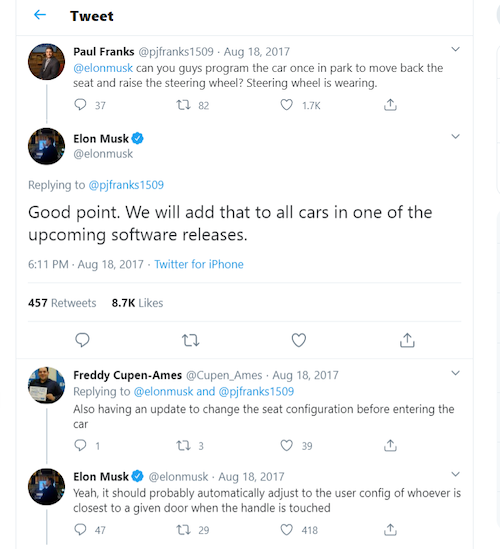
This is a great example of conversational marketing. It combines social listening and engagement with an understanding of the user experience and uses that to inform product design. Judging by the Tweet’s engagement and responses, it genuinely added value to customer experience:
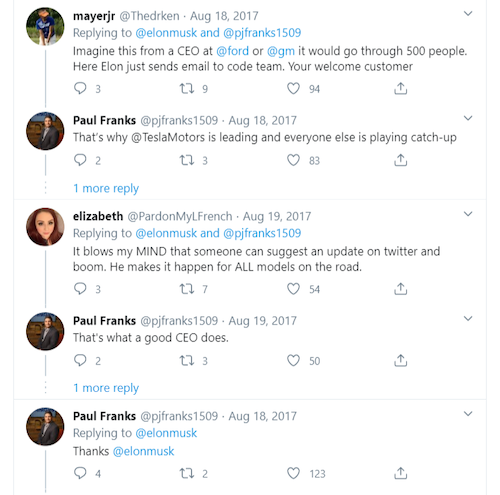
Even if the majority of people engaging in this conversation aren’t Tesla customers, they’re still potential customers. So, while this conversation has directly informed product design, it has also indirectly influenced the opinion of an audience that might someday be in the market for a Tesla. And the effect is overwhelmingly positive.
The 3 parts to conversational marketing
Conversational marketing is no mystery to anyone who’s been involved in conversations with someone over time. Whether between two people or a brand and its customers, it’s composed of three parts:
Listening
Traditional marketers and advertisers hardly listen. They yell and hope someone finds what they’re saying valuable. But that’s not effective for the business and it’s annoying to the consumer. Conversational marketers, on the other hand, do not dominate the conversation. They listen. Whether over phone or social media, conversational marketers spend most of their time determining what their customer cares about so that when they do speak, they make it count.
Understanding
Has anyone ever said to you: “You’re hearing me but you’re not understanding”? This phrase is important for conversational marketers to remember. Because even great listening skills can’t help you if you don’t use the information you take in.
In a real conversation, each builds on the ones before it. If your friend remarks, for example, that talking about work makes them anxious, and that they had a bad experience at the last place you met, they won’t be too happy if you try to reschedule a date for the same place to talk about work.
The same is true in conversational marketing. You have to listen to your customers, but you also have to use what you’ve heard to improve the next conversation. Alicia Collins says:
Think about it: If you called a company yesterday to report a defect in something you ordered, and then you chat them the next day about needing return instructions, you'd expect the person you're talking with to have access to previous interactions and know which product you’re sending back.
Conversational marketing aims to overcome irrelevant experiences like this one by using audience feedback to better personalize interactions.
Engaging
Engaging is an essential part of any conversation. Yet, when you ask people what makes a good conversationalist, they’re more likely to say listening than talking. If traditional advertising is the guy yelling into a crowd with a megaphone, conversational marketers are the people chatting with someone over coffee. This kind of intimate, personal trading of information is what brands should aim for in conversational marketing.
As for the amount of talking you should do, it should follow the same guidelines you use in person. Advertisers should never catch themselves dominating the conversation. Limit yourself to talking only when you can add value. Are you saying the same thing repeatedly when your customers have expressed preferences for a different topic or tone? Listen and analyze to learn how to adjust.
Where conversational marketing happens
Conversational marketing starts and ends with the consumer. And though that is the case with all marketing, conversational marketing takes a more direct approach.
Instead of relying on quantitative means like traditional analytics to learn about customers, conversational marketing focuses on gathering feedback from more qualitative means. Specifically, it’s founded on gathering feedback through “conversations.”
In the digital age, conversations can happen in many ways in many places. Here are the most common for conversational marketing:
When you think of conversation, email may not come to mind. Corresponding via email doesn’t happen in real-time the way conversations do.
Still, email is a fantastic conversational way to learn about your audience. And here’s why: First, the email address is a piece of personal information that people aren’t as hesitant to give you. Name, phone number, address — these are things marketers can be particularly invasive with. Sales letters and phone calls aren’t usually welcomed by consumers, but an email? If they don’t want to read it, your prospects will delete it. Emails are the least invasive way to correspond with customers.
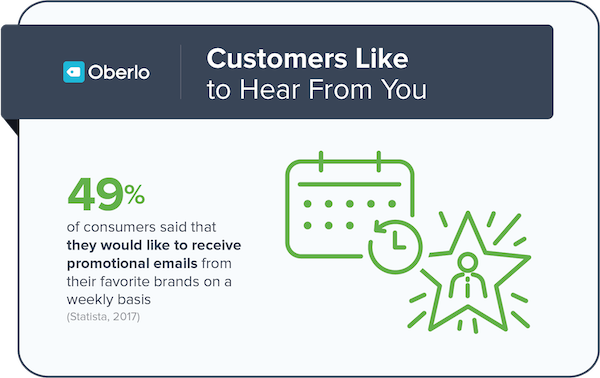
The other thing that makes email so appealing is precisely that it doesn’t happen in real-time. Your audience can answer whenever they want, whether that’s after a meeting at work or after dinner at home.
Ultimately, conversational marketing only works if you can convince people to converse with you. And so you have to go where customers are willing to do that. Email is that medium.
Surveys, or a mailing that simply requests feedback (on a recent purchase or customer service call, for example) can start valuable conversations that improve your marketing.
Social media
Social media is a little closer to traditional conversation than email is. But it also doesn’t demand the time and attention that traditional conversation does over a phone or in person. In this way it’s a great middle-ground between email and phone, allowing users the same benefits: They can converse with you at their leisure, and they don’t have to divulge information that isn’t already public to do so.
But the additional benefit to both users and brands is that it’s much easier to engage in conversation on social media than in email. Social media was made for conversation. Customers want to talk to you there, and they know that even the biggest brands aren’t above engaging with them on platforms like Facebook, Twitter, Instagram, and LinkedIn.

Along with this reason, another makes social media possibly the best channel for conversational marketers: Most of these conversations happen in public. That means you can get involved even if they didn’t start with you. Whether it’s a scheduled industry chat or a spontaneous discussion on a trending topic, brands can easily engage with their audience over social media to gain insight into their behavior and beliefs. Twitter’s Conversational Ads, for example, are designed exactly for this purpose:
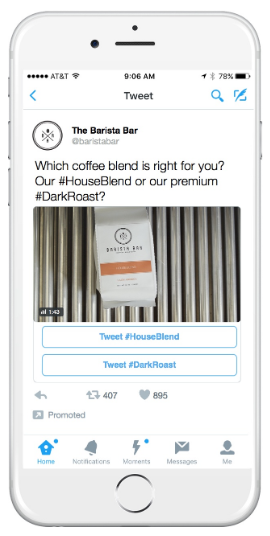
Live chat
Social media has become a popular channel for customer service requests, but the number of businesses using live chat is quickly growing. Nearly 90% of businesses have adopted a form of live chat to field queries from customers, and the reason why is clear: 41% of consumers prefer live chat as a channel for contacting support teams, and they expect an answer to their question in less than 10 minutes.
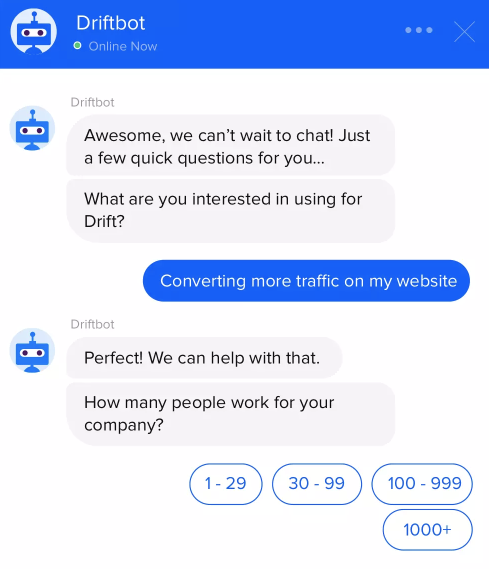
For collecting feedback and resolving problems quickly, there’s hardly a better channel for brands and customers to meet on. Live chat is the closest thing to conversation in text. And while it can be a trove of information for conversational marketers, there are a few major limitations.
For one, you need to be able to resolve issues quickly. And that means staff must be ready when customers beckon. Even though AI is getting better at problem-solving, most bots can still only handle basic queries. Human agents are preferred by most people. That makes scaling very difficult.
Second, live chat is used overwhelmingly for support related questions. People chat with agents looking for solutions, not to have conversations. While you can learn how to improve your marketing by listening here, there’s less opportunity to engage users with meaningful content.
Phone/face-to-face conversations
Of all the ways to make conversation, the traditional way can still provide the most opportunity for valuable insight. Unlike email, social media, or live chat, video, or phone interviews allow conversational marketers to dig deeper.
Here, they’re not limited to multiple choice surveys or constrained by spotty communication across email. They’re free to ask follow-up questions. Not just “what” but “why,” and the conversation can flow both ways.
Of course, while the upside is high, scheduling a customer interview is difficult because it requires the most commitment from the customer. And while it can provide insight for marketing optimization, it’s not as organic as social media. It’s closer to a survey, which to the prospect makes the interaction seem very one-way. You learn about them, but what do they get out of it?

Traditional conversations between brands and customers don’t just happen in interviews, though. Whenever someone calls customer support, they’re having a conversation in real-time. And everything from tone of voice to hold time can affect the perception of your brand.
The same way chat agents can learn a lot about how to improve marketing from customer issues, so can phone agents or ones in person. But also like live chat conversations, these tend to be more about solving a problem and less about the interaction between the brand and consumer. As a result, they’re less in-depth.
Tips for effective conversational marketing
You know where it happens, but how? If you want to succeed at conversational marketing, here are some tips:
Personalize
The best conversations are personal. That means if you’re going to converse with your customers, you should learn about them. Any department that engages in conversations with the consumer should store customer data that can be passed to other arms of the organization. If you chat with a live agent about a problem one day and call the next, you should not have to explain yourself multiple times.

Keep it short
Let’s face it: Brands aren’t friends of the customer. Even when you do engage in meaningful conversation, it will still fall short of any conversation the customer will have with a personal contact. Still, the majority of people engaging with brands need a problem solved. So unless the customer continues the conversation, don’t drag it on longer than it needs to be.
Cater to the customer
Conversational marketers have to be where their customers are. But that doesn’t just mean on the channel they prefer. Among other factors, it means the time and medium they prefer too. If your customers are more chatty on social media at lunch, you should be, too. If they prefer to answer your questions in a survey instead of over the phone, email them a link to your survey. For conversations to add value to both brand and consumer, first they have to start.
When in doubt, listen more
If you spend more time listening and less time crafting the next campaign, your marketing will be significantly more relevant to the consumer. Get on social media, field customer support calls, read reviews of your service. Many times conversations about your brand are already happening, and you can start learning from them right away.
Reward your customers
For brands, the reward of conversational marketing is not only that you learn ways to improve your marketing, but that you build relationships with customers along the way. And though the reward for your customers is they get more relevant marketing, this won’t be enough to get them to complete a survey. When you’re asking for customers to commit time and attention, offer a more practical reward. Here’s an example from Walmart:

Don’t limit yourself to conversation
Just because you’re engaging in conversational marketing doesn’t mean that you have to limit yourself to conversational methods of feedback collection. Don’t stray from traditional analytics. Learn when, where, and how your customers prefer to converse. Open rates, social media usership, bounce rate, etc, can help you determine if you’re being effective.
Personalize your conversational marketing
Conversational marketing can reward both brand and consumer. But like any good conversation, it has to be personalized.
That starts with an ad that speaks to the consumer when, where, and how they want to be spoken to. And that personalization must continue through the post-click landing page and beyond, where data on what you’ve learned can improve the user experience.
Learn more about how to personalize your post-click landing page for better conversational marketing with an Instapage Enterprise demo.

See the Instapage Enterprise Plan in Action.
Demo includes AdMap™, Personalization, AMP,
Global Blocks, heatmaps & more.
